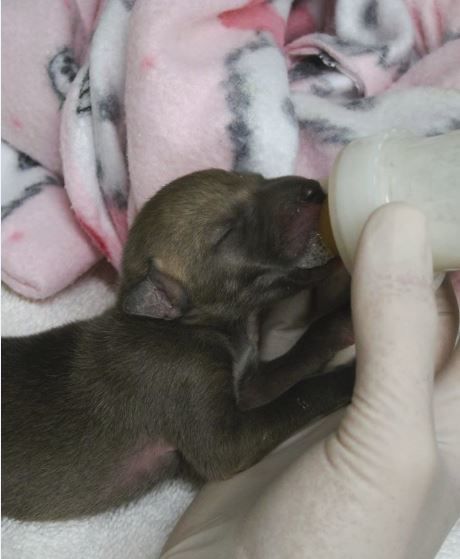WildCare's Wildlife Hospital treats nearly 4,000 ill, injured and orphaned wild animal patients from over 200 species every year. This is one patient's story.
This tiny coyote pup's rescuers had seen a female coyote in the area a few hours before he was found. They said they saw her carrying something in her mouth... maybe a pup? Sometimes a mother coyote will decide that a den site isn't secure and move her babies to a new location. She's only able to carry one at a time, so it can take several trips to move her whole litter.

Coyote mothers take excellent care of their young, but maybe this newborn pup's mother was in the process of moving him when something caused her to drop him. He was found at the bottom of a hill, so possibly he was dropped and rolled. There's no way to know why the mother coyote didn't (or was unable to) return for her lost pup.
Rescuers heard the baby crying and called WildCare for advice. We advised them to get the pup to our Wildlife Hospital, and gave them the contact information for the Marin Humane officer on duty who transported the tiny coyote to WildCare.
Upon intake, the pup was very cold, which is a very dangerous thing for a newborn animal. Very young animals of many species are not able to thermoregulate (maintain their own body temperature), so getting chilled is a serious health risk for them. Any time you find a baby animal that is cold, he needs immediate help.

Medical Staff gently warmed the coyote pup and, once he was warm, gave him subcutaneous fluids and offered him his first taste of the species-specific baby formula we feed our orphaned wildlife.
A reunite attempt was discussed (WildCare's first choice is always to reunite baby animals with their mothers) but this baby had arrived at WildCare dangerously cold and had fly eggs in the corners of his eyes and his mouth which indicated he had been alone for a long time. He was too ill to attempt to return him to his mother's care, so he will grow up in Foster Care.
Watch him in the video above being fed his bottle. This video was taken two days after intake, so he has grown accustomed to the taste of the formula and the experience of suckling from a nipple.
A tiny coyote like this will open his eyes at about 14 days old, and it's very important that the first thing he sees is another coyote. WildCare will be reaching out to other wildlife care centers in the area to find another orphaned pup about this baby's age with which to pair him. He'll grow up wild with his new sibling(s) and he will eventually be released once he's old enough.
Watch this baby in the video below being stimulated to urinate and defecate. The mother coyote would lick her baby to stimulate him, but in the Wildlife Hospital we use a damp cotton ball! Stimulating elimination helps keep the baby healthy and also keeps the den clean.
WildCare is a 501(c)3 nonprofit organization supported almost entirely by private donations and individual memberships. Visit us online at wildcarebayarea.org.
